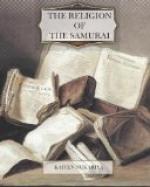The Mahayana-tripitaka.
The Sutra Pitaka.-The Saddharma-pundarika-sutra,
Samdhi-nirmocana-sutra, Avatamsaka-sutra, Prajnyaparamita-sutra,
Amitayus-sutra, Mahaparinirvana-sutra, etc.
The Vinaya Pitaka.—Brahmajala-sutra, Bodhisattva-caryanirdeca, etc.
The Abhidharma Pitaka.—Mahaprajnyaparamita-sutra, Mahayana-craddhotpada-castra, Madhyamaka-castra, Yogacarya bhumi-castra, etc.
The Hinayana-tripitaka.
The Sutra Pitaka.—Dirghagama, Ekottaragama,
Madhyamagama,
Samyuktagama, etc.
The Vinaya Pitaka.—Dharmagupta-vinaya,
Mahasamghika-vinaya,
Sarvastivada-vinaya, etc.
The Abhidharma Pitaka.—Dharma-skandha-pada,
Samgiti-paryaya-pada,
Jnyanaprasthana-castra, Abhidharma-kosa-castra, etc.
The term ‘Tripitaka,’ however, was not known at the time of Shakya Muni, and almost all of the northern Buddhist records agree in stating that the Tripitaka was rehearsed and settled in the same year in which the Muni died. Mahavansa also says: “The book called Abhidharma-pitaka was compiled, which was preached to god, and was arranged in due order by 500 Budhu priests.” But we believe that Shakya Muni’s teaching was known to the early Buddhists, not as Tripitaka, but as Vinaya and Dharma, and even at the time of King Acoka (who ascended the throne about 269 B.C.) it was not called Tripitaka, but Dharma, as we have it in his Edicts. Mahayanists unanimously assert the compilation of the Tripitaka in the first council of Rajagrha, but they differ in opinion as to the question who rehearsed the Abhidharma; notwithstanding, they agree as for the other respects, as you see in the following:
The Sutra Pitaka, compiled by Ananda; the Vinaya Pitaka, compiled by Upali; the Abhidharma Pitaka, compiled by Ananda—according to Nagarjuna (Mahaprajnyaparamita-castra).
The Sutra Pitaka, compiled by Ananda; the Vinaya Pitaka, compiled by Upali; the Abhidharma Pitaka, compiled by Kacyapa according to Huen Tsang (Ta-tan-si-yu-ki).
The Sutra Pitaka, compiled by Ananda; the Vinaya Pitaka, compiled by Upali; the Abhidharma Pitaka, compiled by Purna—according to Paramartha (’A Commentary on the History of the Hinayana Schools’).
The above-mentioned discrepancy clearly betrays the uncertainty of their assertions, and gives us reason to discredit the compilation of Abhidharma Pitaka at the first council. Besides, judging from the Dharma-gupta-vinaya and other records, which states that Purna took no part in the first council, and that he had different opinions as to the application of the rules of discipline from that of Kacyapa, there should be some errors in Paramartha’s assertion. Of these three collections of the Sacred Writings, the first two, or Sutra and Vinaya, of Mahayana, as well as of Himayana, are believed to be the direct teachings of Shakya Muni himself, because all the




